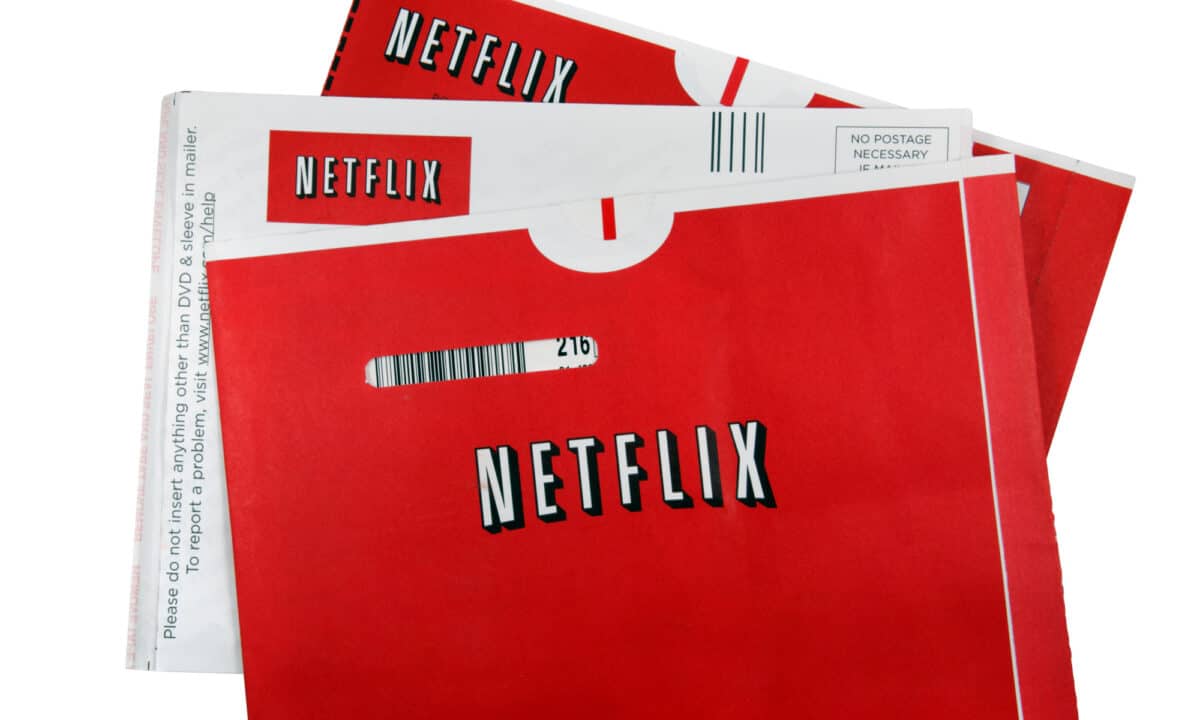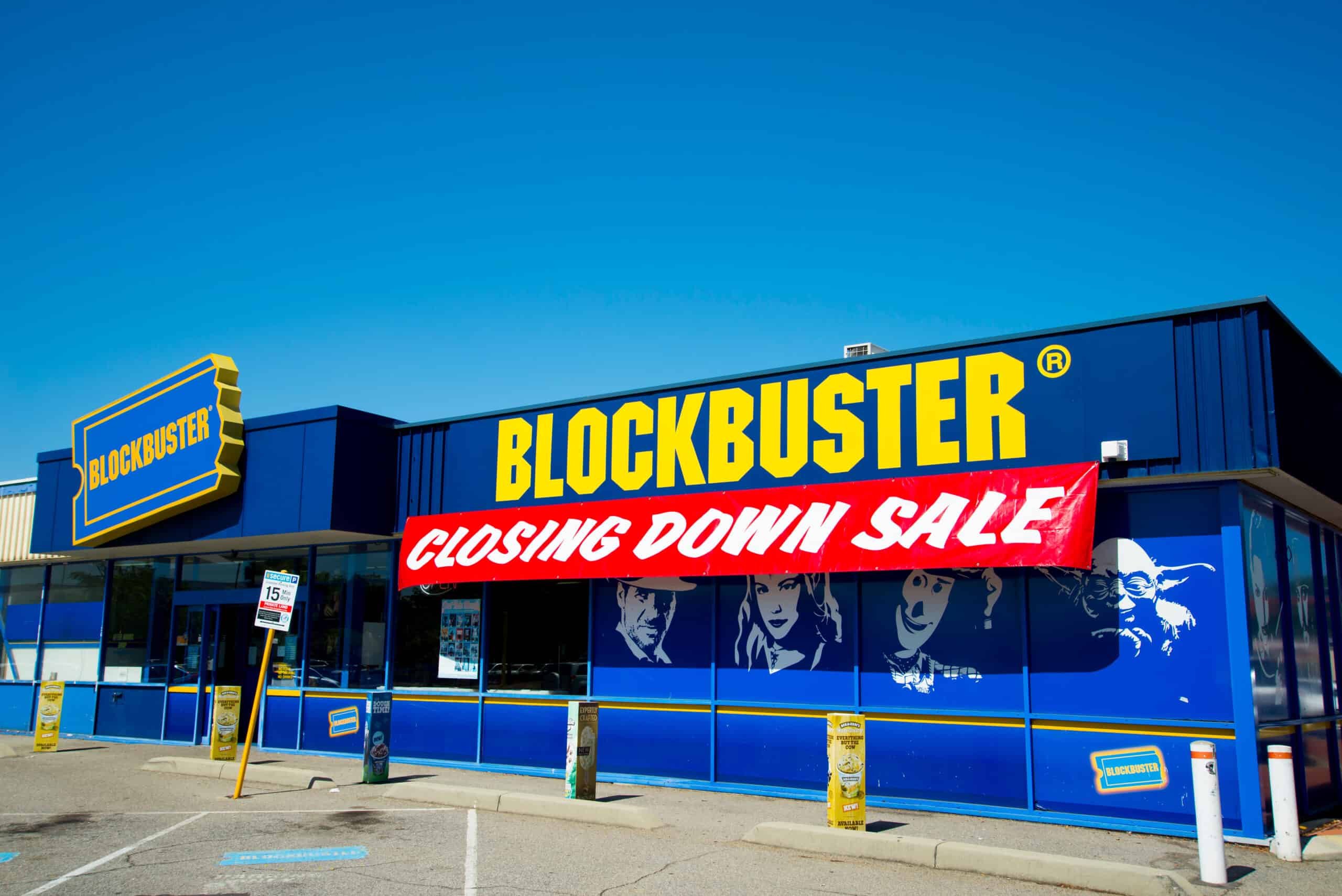Before the founding of Netflix and Redbox, Blockbuster was the king of the video rental industry in the 90s and early 2000s. Most Xennials can recall those old days when, if you wanted to watch a movie, you’d walk into a video store in your neighborhood to rent a DVD or VHS tape. Then, Blockbuster had over 9,000 stores across the globe and over 45 million registered customers. It offered a vast selection of movies and had an unparalleled snack section making it the most convenient store for all in-house entertainment and snacking. But this did not last forever; Blockbuster failed.
So what happened? How could a company that was so established only have one store left worldwide, in Bend, Orengo? How did it get here? Why did Blockbuster fail?
Quick Facts
- Year Founded
- 1985
- Founders
- David Cook
- Industry
- Entertainment Industry
- Headquarter
- Dallas, Texas
- Key People
- James W. Keyes – CEO
- Notable Products
- Video Rentals
- Website
- https://bendblockbuster.com/about/
The History of Blockbuster: What to Know
Blockbuster opened its first video rental store in October 1985 in Dallas, Texas. It held a large inventory (8,000 VHS and 2,000 Beta) which gave it a competitive edge over other reputable small-scale stores operating at the time.
This video rental chain expanded rapidly, becoming the world’s largest movie and video game provider. It had more than 4500 stores across the US and other branches overseas in its peak years. But twenty-five years after its entrance into the video rental business, Blockbuster filed for bankruptcy.
This led to the closure of all its stores apart from the Bend, Orengo franchise store, which remains open today. Inefficient management and the great recession significantly contributed to Blockbuster’s decline. Unbelievably, it could not leverage its strong networks and resources to shoulder its challengers.
But is that why Blockbuster failed?
The Founding of Blockbuster: How It Happened
David Cook, the founder of Blockbuster, was a database developer and a solutionist who could easily spot a viable business opportunity and capitalize on it. In 1978 he opened a database service company with the aim of developing software for the oil and gas business.
Within five years, the company had doubled its profits. Cook took it public, raising $ 8.4 million. Six months later, there was a massive amount of surplus oil in the market. Thus, oil & gas companies had to cut down discretionary expenditures, which meant no purchasing of optional software, translating to low sales for Cook’s database company.
He thought of investing the $ 8.4 million earned from the IPO elsewhere. So, he looked for a market that lacked a key player that he could dominate and saw that opportunity in video rentals. As an imitator entrepreneur, Cook decided to go large scale and revolutionize the growing movie industry. He opened his first store in 1985, expanding to three more stores in 1986.
Using his innovative mind, Cook set Blockbuster apart from the competition. He developed a computerized system that made it easy and efficient for the company to manage stock and identify its customers’ needs. This helped Blockbuster focus on movies that people would rent more frequently.
In 1987, Cook divested part of his video rental business to Wayne Huizenga, the founder of Waste Management, Inc, the largest garbage collection company worldwide. Huizenga took over the leadership of Blockbuster. He relocated the company’s Headquarters from Dallas, Texas, to Fort Lauderdale, Florida.

Blockbuster Through The Decades: Megahit to Flop Timeline
David Cook relinquished control of Blockbuster to Huizenga, a successful businessman who built the entertainment company into a thriving business.
From 1988 to 1996
Huizenga embarked on expanding Blockbuster. Using Ray Kroc’s expansion strategies and the same techniques that led to the growth of his Waste Management Company, Huizenga bought and built new stores in the most convenient locations. Thanks to him, Blockbuster was a multibillion-dollar company by the early 1990s.
But it lost over 10% of its shares in 1991 after Time Warner, an American cable TV company, publicized its intent to upgrade its cable system. Huizenga saw this as a huge threat and branched out to the broadcasting and publication industry in 1993. He invested in Viacom, a company that would one year later buy Blockbuster for $ 8.4 billion.
However, the merger did not save Blockbuster’s market value. Its shares dropped further, decreasing its net worth to approximately $4.6 billion towards the end of the decade. In 1996 Blockbuster moved its headquarters to the Renaissance Tower in Dallas.
From 1997 to 2005
In 1997 John Antioco joined Blockbuster as the new CEO. He was expected to save the company from sinking further since it recorded a massive decline in sales. Using entrepreneurship skills, Antioco managed to improve Blockbuster’s revenue. He increased the number of stores to over 9,000 globally.
To expand its market reach, Blockbuster acquired 221 films under its film studio DEJ Productions in 1998 and sold them to First Look studio in 2005. It also bought over 200 video rental stores in the UK. But its bottom line was still at stake regardless of these new investments. Hence was forced to sell its Irish video stores.
Probably, Blockbuster would have made more income if they hadn’t declined the Warner Bros DVD rental deal in 1998. It lost some of its customers to rental retailers who seized this opportunity.
In 2000 Blockbuster failed to acquire Netflix for only $ 50 million. This was a miscalculated decision; Netflix became their main challenger years later. Nevertheless, Blockbuster continued to acquire several movie and game trading chains.
Determined to reclaim its lost market share, Blockbuster introduced its first online DVD in 2003 but was unsuccessful. The same year Viacom split off from Blockbuster. This followed a lawsuit against the video rental giant for false advertisement. In 2005 it launched a campaign to promote no more late fines but had inflicted hidden fees and that raised disputes.
From 2006 to 2010
Blockbuster’s adversities led to a gradual decline in its profits. Executives needed a new approach that would help grow and protect the company’s bottom line. Entering into too much debt and not making any substantial profits was a considerable threat. Hoping to save the sinking video rental chain, executives replaced John Antioco with James Keyes in 2007.

Keyes’ strategy to save Blockbuster failed. He thought increasing the cost of online DVD rental services and withdrawing free movie offers was a great idea but it led to a drastic fall in sales. The new management’s attempt to salvage Blockbuster from plummeting didn’t come to fruition. In 2010 the once video rental leader filed for bankruptcy.
How Did Blockbuster Make Money?
Blockbuster was very strategic in its revenue generation. It entered into agreements with most movie distribution companies on sharing costs and profits related to movie rentals. It would pay the movie distribution company 40% of the rental fees and retain 60%. It also would leverage its computerized inventory management system to identify the movies to stock, based on customers’ needs and preferences, which would translate to more sales.
Unlike its industry rivals, Blockbuster would be given first access to movie releases at a lower rental fee. But other than extending lower charges to its customers, it would maximize these deals to bring in more money.
Over and above, Blockbuster charged a hefty late fee ($1 per day) for any movie rental that is not returned by its due date. It also charged monthly subscriptions to customers at a minimum rate of $19.99 for three movie rentals per month. To deliver more convenient services, this movie rental retailer would provide its customers with snacks at demand-based pricing. All these money-making strategies contributed significantly to Blockbuster’s profits.
However, it is out of the late fees charges that its primary competitor (Netflix) was born in 1997. Like many Blockbuster’s customers, Reed Hastings, Netflix co-founder, was angered for being charged a $40 late fee. Though he paid the fine, he was determined to offer a solution that delivered convenience in the most efficient way possible at ‘No late Fees.’
Thus he created Netflix and introduced a model that allowed people to order movies online and would deliver them right to their doorstep. This eliminated the hustle of walking into a Blockbuster store to rent a movie and the fines that came with late returns.
So Did Netflix Kill Blockbuster?
It didn’t take Netflix more than a year after its formation to gain a good share of the movie rental market. Employing promotional strategies that proved more effective weakened its main competitor, Blockbuster. Hence was able to grow an extensive customer base more than any other movie rental business at the time.
When Netflix started its DVD rental business, only a few households had DVD players. However, it took the risk of partnering with companies like Sony and HP to offer free DVD rentals to any customer who bought a DVD player. As a result, Netflix obtained more new subscribers.
In 1999 Netflix received a $30 million investment from Arnault, a private company based in France. It used the funds to launch its subscription-based service that saw its customers rent multiple DVDs at a monthly fee of only $16.
Regardless of the increased website traffic, Netflix was struggling to keep afloat. And thus, Reed and Marc Randolph, the company co-founders, approached Blockbuster in 2000 with the intent to sell their online rental business at $50 million but were ironically turned down by Blockbuster executives.
A few months later, DVDs became popular, giving Netflix an edge over Blockbuster and other industry rivals. Two years after the brutal rejection, Netflix was recording profits. To match customer demands, Blockbuster copied and pasted Netflix’s idea of online DVD rental services, but Blockbuster failed. Slowly its revenue began to drop.
By 2005 Netflix was making huge profits. In 2007 it launched its streaming services, allowing its subscribers to watch their favorite videos at their convenience. Netflix web traffic continued to soar higher. Blockbuster was declared bankrupt in 2010, and Netflix dominated the video rental market.

Why Did Blockbuster Fail?
So, why did Blockbuster fail? Here are a few main reasons why Blockbuster failed:
1) The Netflix Affect
It can be argued that Netflix partly contributed to Blockbuster’s downfall. However, Blockbuster failed to make decisions that would allow them to stay competitive in the changing retail environment.
2) Failed To Pivot Quickly and Competently
Blockbuster was too slow to adapt to the shifting customer needs and preferences. They got comfortable with their business model and ignored new technologies changing the entertainment industry.
And by the time they realized they needed to evolve their business model to stay on top of the competition, Netflix had already rolled out its subscription video-on-demand model. Netflix’s model proved to be of greater convenience and value, which attracted more customers, causing a dent in Blockbuster’s market share.
3) Failed To Create Customer Value
Blockbuster was too company-focused rather than customer-focused. Rather than thinking of how to improve customer experience, the company concentrated more on strategies that would help maximize its returns. For instance, Blockbuster failed to take a moment to analyze how its customers would benefit from Netflix’s offer in the near future. Instead, it focussed on how much it would spend on the deal.
4) Failed To Restructure
Blockbuster had a chance to survive and thrive regardless of losing its credibility and customers. However, it wasn’t ready to restructure its operations. Blockbuster had to build its online platform to compete with Netflix, which meant dropping late fees. Unfortunately, Antioco was fired before he could fully make these changes, and the company went back to its old ways.
5) Had a Huge Debt
Blockbuster didn’t have enough money to invest in innovative models that would help it remain competitive. As a brick-and-mortar business with over 9,000 stores, its operating costs must have been higher than that of its online rivals. Besides, the company had borrowed $950 million to pay for dividends which dwindled its bottom line. Netflix, Redbox, Amazon, Outerwall, and Cummins-Alison created better business models that eliminated the need to walk into a physical store to rent a movie or a game, hurting Blockbuster’s revenue and profits.
The Last Blockbuster Store
Although Blockbuster had closed all of its corporate-owned stores by 2014 several Blockbuster franchise stores remained, licensed to use the Blockbuster brand. However, in 2019 the store in Bend, Oregon became the very last “Blockbuster” store in the world. Often called the Last Blockbuster, the store has since become something of a tourist attraction. The store currently stocks approximately 1,200 titles and still has a good customer base. It is one of only three remaining video rental stores left in North America.
Summing Up
If you are not ready to disrupt yourself to stay ahead of the curve, be prepared to lose your customers to your competitors. If you are in business, keep a pulse on the changing trends in your business environment. Remember, consumers will not stick with the most popular brand but will go where they are offered better services or products. Blockbuster failed to innovate and take risks that would help it to survive and thrive in a competitive environment.
The image featured at the top of this post is ©Adwo/Shutterstock.com.

